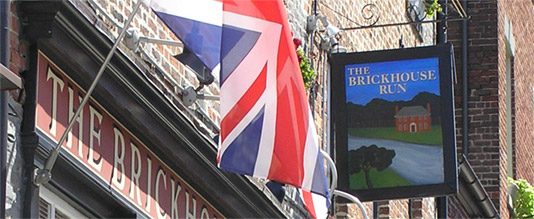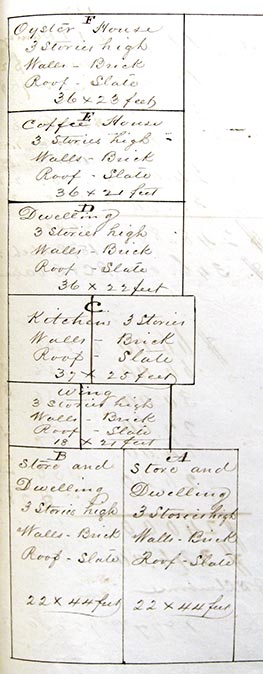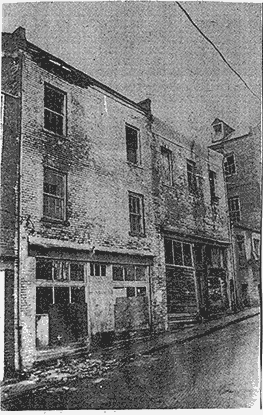The Design of The Brickhouse Run
The Brickhouse Run borrows heavily from the 1000-year-old tradition of the British Public House. It is not meant to feel like a pub which has been plucked from a town in the British countryside and dropped in Petersburg. Rather, we like to think that if Petersburg, Virginia were part of Britain this is what its pub would be like. This philosophy has affected almost every choice made in the design of the pub, from the menu through the pictures on the wall.
The Brickhouse Run is laid out in two rooms like many of the coaching inns of the eighteenth century in Britain. The Public Bar, with its flagstone floor, exposed beams and somewhat rough nature is where the locals and mostly men would meet. The Dining Room or Lounge Bar which is carpeted and somewhat genteel nature is for people who have come in on the stagecoach and women who did not like the conversation of the local farmers and laborers. One can find many pubs today in England which still maintain the distinction between the public bar and the lounge and may have other rooms for playing games or a dining room separate from the lounge.
The Brickhouse Run is designed for drinking, conversation and eating. There is no television (except on special occasions, like election night, the final game of the World Series or a coronation). The bar, designed and built by Mark Pehanich, is set up to encourage conversation. Since most people stand and drink in British pubs, there are only a few bar stools. The brass rail and small overhang encourage people to face each other while sitting or leaning by the bar rather then sitting facing the bartender. The brass hooks under the edge of the bar top are for hanging purses or jackets. The bar is made of mahogany to the average dimensions of several pub bars in England. The molding around the bar panels is unique to Petersburg and was reproduced from an old door built here.
 |
| Our pub sign features a painting of an imaginary virginia brick house alongside a stream. |
History and Architecture of the Buildings
The buildings now occupied by The Brickhouse Run, 407 and 409 Cockade Alley, were originally two of four buildings which served as dependencies to the home of Nathaniel Friend. 407, which contains the Public Bar, was originally the kitchen, and 409 was a warehouse or lumberhouse. The Friend House sits on the corner of Bollingbrook Street and Cockade Alley and is connected to 407 and 409 by an addition to the rear.
407 and 409 Cockade Alley and the Friend House were built in 1815–1816 by Nathaniel Friend, a wealthy merchant and plantation owner, following the Great Fire of 1815. There is some evidence that there was an existing brick building (circa 1808–1815) on the site, and some evidence of it may be found in the south wall of the Public Bar. The buildings may have been two stories high when they were first constructed, but it is clear from insurance policies that by 1818 they were three stories high. Two more buildings in the row, 411 and 413 Cockade Alley, were built in 1822. Only the first two floors of 411 remain today and 413 was demolished in the early part of the twentieth century.
As dependencies these buildings served practical purposes in support of Nathaniel Friend, his business and his household. After the Civil War his heir, Charles Friend, leased them to a variety of people for private business. These varied uses continued through the twentieth century as the Friend house complex was divided and sold to several different owners.
A survey of insurance policies and city business records show that the buildings were used for the following during their history:

409 Cockade Alley
1816–1829—Lumberhouse
1837—Bakehouse
1844—Tin Shop/Dwelling
1851—Kitchen/Dwelling
1858—Dwelling
1859–1885—Unknown
1886–1914—Restaurant
1915—Barber Shop
1916–1917—Vacant
1918–1920—News Agent
1921–1929—Barber Shop
1930–1941—Vacant
1943–1967—Warehouse
1968–1988—Vacant
1989–1996—Craft Shop
2000–present—
The Brickhouse Run Dining Room

407 Cockade Alley
1815–1858—Kitchen/Dwelling
1859–1878—Unknown
1879–1907—Barber Shop
1908–1911—Shoemaker
1912–1914—Butcher Shop
1915–1919—Warehouse
1920–1922—Poolroom
1923—Unknown
1924–2000—Vacant
2000–present—
The Brickhouse Run
Public Bar
407 and 409 Cockade Alley have been altered numerous times in the last 185 plus years. Originally the upper floors of the buildings were accessed by an eight foot alley along the back or east wall. The back door led to a stairwell and upstairs was living quarters for employees and slaves. The façades of both buildings were probably very similar when they were first constructed. Each appears to have had three windows on the second and third floors and two windows and a door on the ground floor. Wooden shopfronts were probably not added until late in the nineteenth century.
Since the Friend House contained two “apartments,” the Kitchen, located in the present Public Bar, was also divided into two separate rooms, each with access to the main house. A central chimney, which disappeared sometime in the later half of the nineteenth century, supplied each side with a cooking fireplace. The entrance on Cockade Alley led into an arched covered walkway through the building to the back alley. The main floor of the kitchen was approximately three feet below the present level of the floor so that kitchen workers could enter the basement of the Friend House and then proceed upstairs to the dining rooms. Evidence of the two different floor levels can be found by examining the brickwork left by the archway on the north wall and the ceiling of the kitchen on the south wall. Behind the bar back are the tops of the two doors leading to the Friend House. These doors, which can also be seen in the basement of the Friend House, were bricked over in the mid-nineteenth Century.
The Lumberhouse (the Dining Room) was divided into two basic rooms on the ground floor. The front room was probably used for storage and wholesale selling of goods Friend received from ships landing at City Point or Petersburg Harbor. It contains no fireplace as Friend dealt primarily in textiles and other flammable goods. The back or east room probably housed the warehouseman’s office. It still retains its fireplace. A wall probably separated the two rooms.
By 1930 both buildings had fallen on hard times. Vacant and deteriorating, 407 Cockade Alley had suffered damage to its roof, lost its second floor, arched way, and chimney through adaptations by its users and neglect. These alterations caused the building to be abandoned. From that time until 2000 it would see the loss of all of its internal woodwork, including the floors, its shopfront, a portion of its front wall and the entire back wall at the third floor level. Its partner, 409 Cockade Alley would fare somewhat better, but damage to its roof would cause it to lose the greater portion of its floors and the shopfront. In 1975 both buildings were slated for demolition by the City of Petersburg. They were saved by action of the predecessor of the Historic Petersburg Foundation and in 1980 they were purchased and stabilized by Josh and Ingrid Greenwood. The Greenwoods installed steel structural beams at each floor level, installed new floors in 409 Cockade Alley and made the buildings weathertight. In 1997 the Greenwoods sold the buildings to Ella and Steve Dickinson who rehabilitated the buildings from top to bottom. The buildings now consist of the Restaurant/Pub on the Ground Floors and two apartments on the second and third floors.





